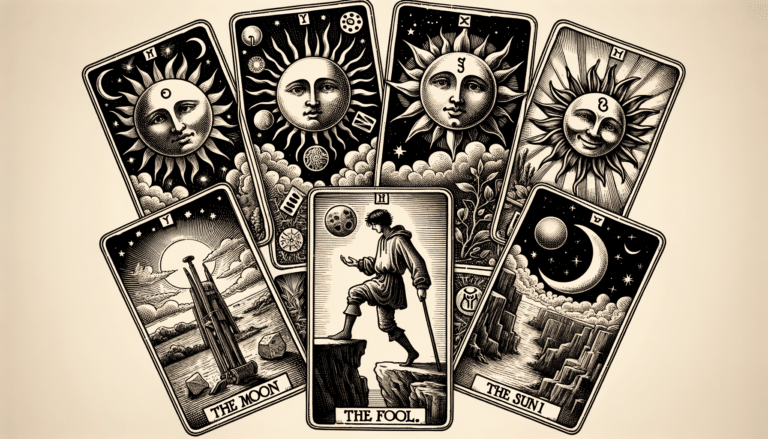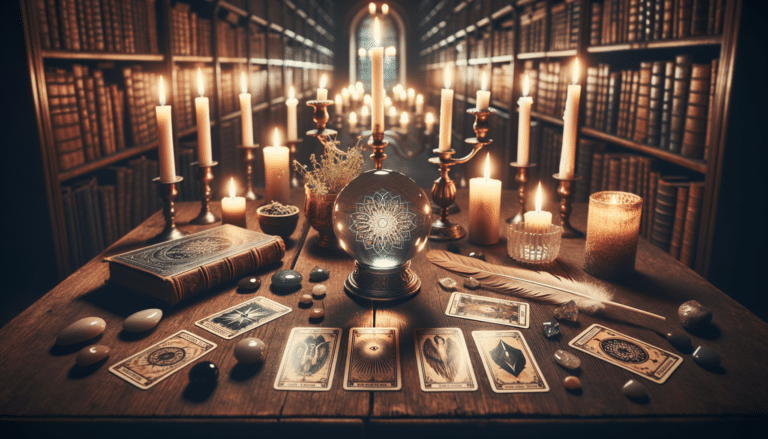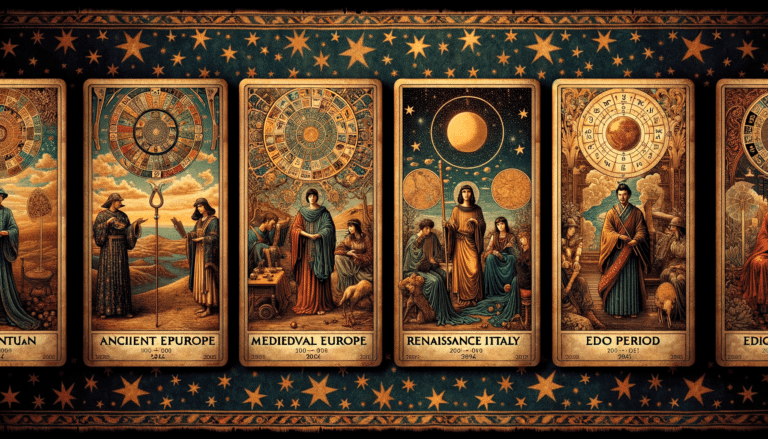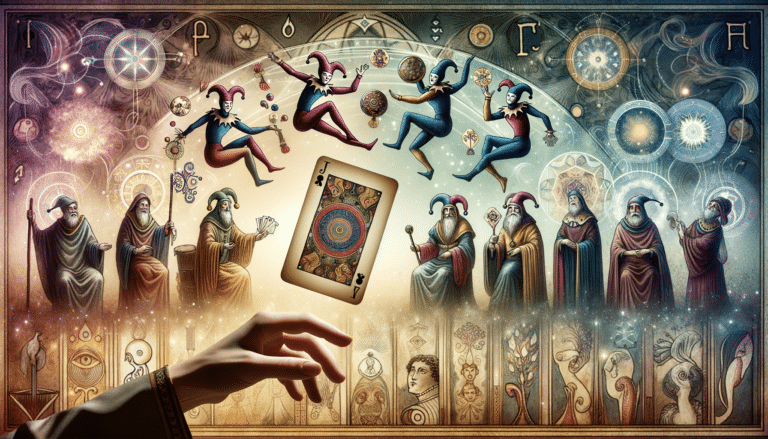Evolution of Tarot Card Illustrations: 7 Key Insights
As the cards lay before you, each bearing its own mystique, you can’t help but wonder about the journey tarot imagery has taken through time. You’re about to embark on a historical quest, tracing the evolution of tarot card illustrations from its medieval origins to the digital age.
You’ll discover how the Renaissance breathed life into arcane symbols and how the Occult Revival reshaped them with esoteric knowledge.
You’ll explore modern design innovations that have redefined these cards for contemporary seekers.
Along the way, you’ll learn how digitization has expanded the reach of tarot artistry, allowing for a fusion of tradition and innovation.
So, shuffle the deck of history and reveal the secrets behind the tarot’s visual transformation with these seven insightful tips.
Key Takeaways
- Tarot cards originated in the 15th century as hand-painted playing cards for the Italian nobility, reflecting the social and religious ethos of the time.
- The Renaissance era enriched tarot illustrations with classical art and humanist ideals, adding layers of meaning and deepening their symbolism and significance.
- The Occult Revival of the 19th and early 20th centuries reshaped tarot illustrations, incorporating symbols from various mystical traditions and conveying complex spiritual concepts.
- Modern tarot designs depart from traditional imagery, embracing diverse themes and artistic styles, challenging conventions, and offering a mirror to contemporary issues and themes.
Origins of Tarot Card Illustrations

While you’re exploring the roots of tarot card illustrations, it’s essential to start with their early emergence in the 15th century as hand-painted playing cards for the Italian nobility. These weren’t merely recreational tools but also objects of art, showcasing the era’s skillful craftsmanship. The pictorial symbols on these cards were rich in allegorical meaning, reflective of the social and religious ethos of the time.
The tarot’s imagery is a cultural amalgamation, borrowing from various traditions and mythologies. As you delve deeper, you’ll find that the illustrations aren’t just random drawings but are steeped in the medieval iconography that was prevalent across Europe. Each image, from the noble Emperor to the enigmatic Hermit, carries with it a history of thought and symbolism.
Understanding tarot’s origins helps you appreciate the complexity and depth these cards offer. They’re not just predictors of the future; they’re a visual narrative of human experiences and beliefs. As you trace the lineage of these symbols, you’re unraveling the tapestry of a bygone era, learning how ancient wisdom has been passed down through the art of tarot.
Renaissance Influence
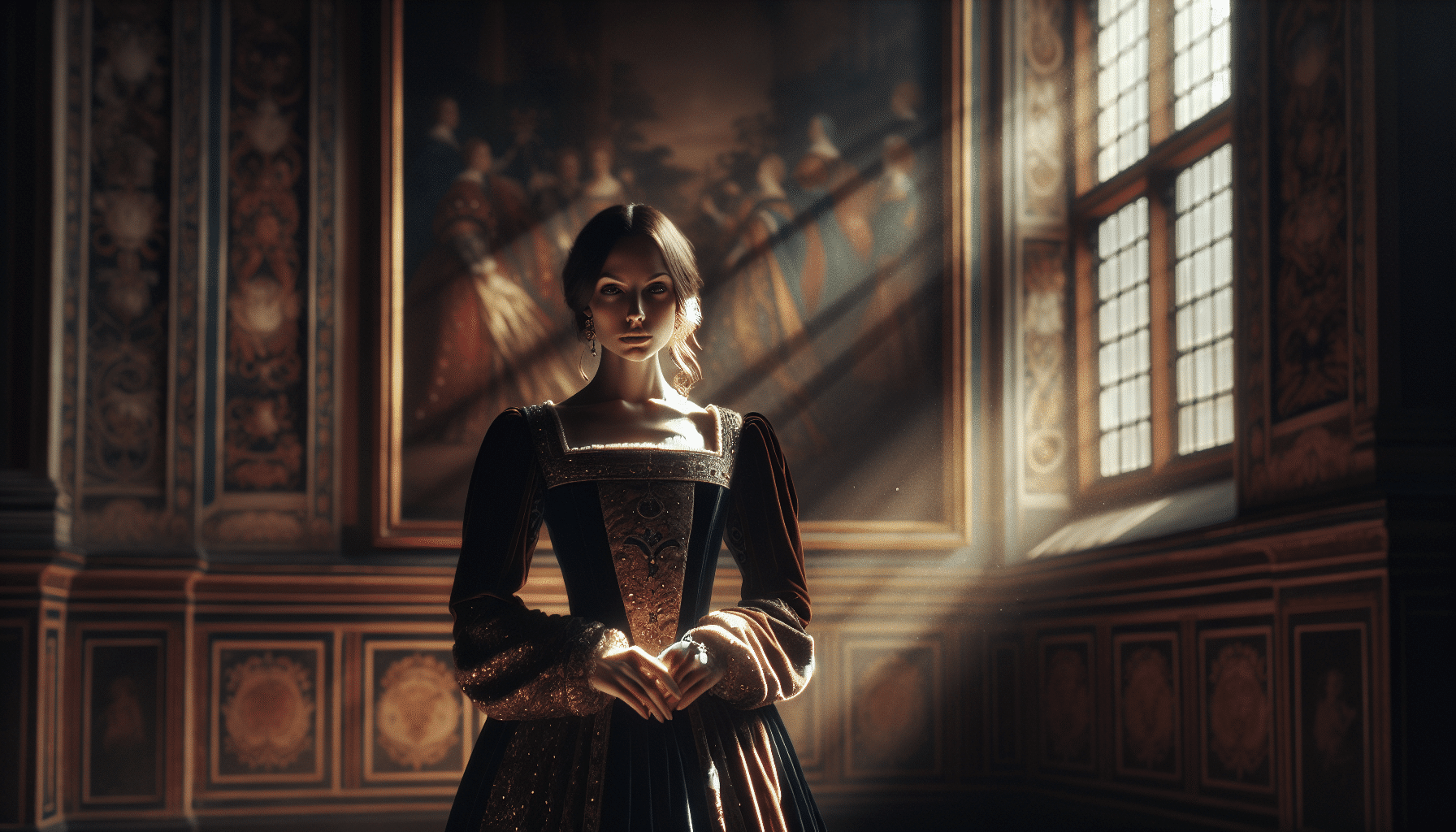
Having explored the medieval roots of tarot imagery, you’ll now see how the Renaissance era further enriched these illustrations with its revival of classical art and humanist ideals. This period of awakening bridged the gap between the mystical and the rational, infusing tarot cards with a new depth of artistic symbolism and cultural appropriations.
Artistic Symbolism
- The High Priestess now embodies wisdom with classical columns and a pomegranate patterned veil, drawing from Greek and Roman influences.
- The Chariot shows a victorious leader, akin to Roman triumphs, symbolizing control and willpower.
-
The Star represents hope and inspiration, often depicted with a nude figure like Botticelli’s Venus, celebrating natural beauty and divine connection.
Cultural Appropriations
- Renaissance fairs and costumes in tarot aren’t mere historical snapshots but a blend of different eras, creating a tapestry of time in card form.
- The transition from medieval to Renaissance styles showcases the evolution of societal values and the human condition.
- Tarot cards became mirrors reflecting an era that sought to harmonize the spiritual with the empirical, asking you to find your place within that balance.
As you delve deeper, you’ll appreciate the layers of meaning each card acquired during this transformative age.
Check out our Tarot Cards & Oracle Decks here…
Occult Revival Transformations

The Occult Revival of the 19th and early 20th centuries significantly reshaped tarot card illustrations, infusing them with mystical symbols and esoteric knowledge that you’ll now explore. This era marked a time when tarot imagery became more than just a game – it transformed into a tool for divination, personal growth, and a visual representation of occult philosophies.
You’ll notice that during this period, Symbolic Syncretism became a defining feature of tarot cards. Esoteric Artists, inspired by various mystical traditions such as Kabbalah, alchemy, and astrology, began to incorporate a wide range of symbols into the artwork. They aimed to create a visual shorthand that conveyed complex spiritual concepts and universal human experiences.
As you delve into the intricacies of tarot from this era, you’ll see that the cards became layered with meaning. Each illustration was a tapestry of ancient and contemporary wisdom, designed not only to be aesthetically pleasing but also to function as a key to unlock deeper metaphysical insights.
The Occult Revival brought forth iconic decks, such as the Rider-Waite-Smith tarot, which remains influential to this day. Through these decks, you can trace the evolution of tarot from a simple card game to a profound system of esoteric knowledge.
Learn more with these tarot books here…
Modern Design Innovations and Their Effect on the Evolution of Tarot Card Illustrations

In modern tarot designs, there is a bold departure from traditional imagery, embracing diverse themes and artistic styles. Artists are venturing into symbolic abstraction, where each card becomes a canvas for personal expression and deep psychological exploration. This reimagining of tarot’s essence is not just a reinterpretation of the Fool or the Lovers; it is a complete transformation.
Symbolic Abstraction:
- Evokes curiosity through enigmatic visuals
- Invites introspection with less prescriptive symbolism
- Encourages a personal connection by leaving interpretation open-ended
As you delve into these new decks, you will experience cultural fusion, where diverse artistic traditions and iconographies blend seamlessly. This fusion creates a rich tapestry that reflects our globalized society, making tarot more inclusive and resonant on a universal level.
Cultural Fusion:
- Celebrates diversity, connecting you to a wider range of experiences
- Fosters a sense of unity, as varied cultural symbols find common ground
- Enriches your readings, adding layers of meaning from different worldviews
The tarot community thrives on innovation, and you are at the forefront of this creative evolution. Each card tells a story, and modern tarots invite you to be the author of your unique narrative.
Modern Innovations:
- Inspire awe with groundbreaking aesthetics
- Challenge conventions, urging you to think beyond the traditional
- Offer a mirror to the present, reflecting contemporary issues and themes
Learn even more secrets of the history of tarot here…
Digitization and Tarot Artistry
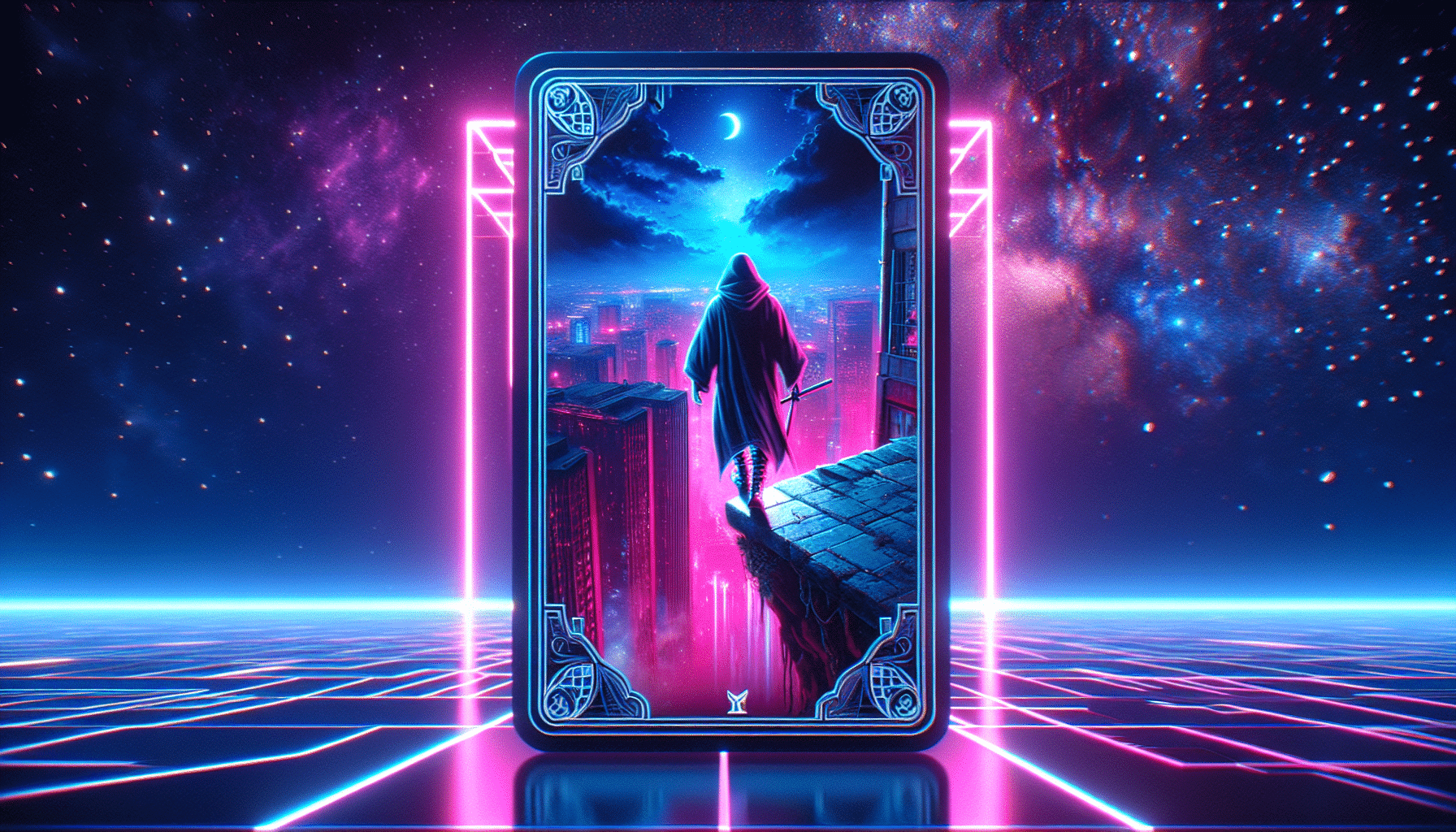
As you explore the world of tarot, you’ll notice how digitization has transformed card illustrations, making them more accessible and varied than ever before. Digital archives have become a treasure trove for enthusiasts and scholars alike, preserving the rich history of tarot artistry while providing a platform for comparison and study. With high-resolution images of cards from different eras at your fingertips, you’re able to observe the evolution of symbolism and style with unprecedented ease.
Moreover, artistic software introduces a new realm of possibilities for creators. These powerful tools allow artists to experiment with intricate designs and a multitude of textures that would be challenging to produce by traditional means. You can now find tarot decks that aren’t only visually stunning but also deeply personal, reflecting the individual style of the artist. This digital approach brings a fresh perspective to an ancient tradition and ensures the continual renewal of tarot imagery.
Whether you’re a casual admirer or a dedicated tarot reader, the digitization of tarot expands your horizons. It invites you to engage with a dynamic art form that’s constantly reimagining itself through the lens of modern technology.
Conclusion
As you’ve journeyed through the mystical corridors of tarot’s visual tapestry, you’ve seen the cards bloom from medieval archetypes to modern masterpieces. Picture the vivid threads of history woven into each card, reflecting the evolution of human consciousness.
Now, digital brushstrokes innovate these sacred symbols, infusing them with new life. With every shuffle, you’re not just glimpsing the future; you’re holding centuries of artful transformation in the palm of your hand.

About The Author – Allen Hill
Allen Hill, the force behind Unknown Truth Tarot, has a YouTube following 6-times bigger than the population of his hometown, Miamisburg, Ohio. From his spiritually rich blog on Tarot and crystals to his role as CEO of The Unknown Truth Tarot Metaphysical Shop, Allen’s passion for the metaphysical shines through.
A master Tarot reader and “crystal junkie,” Allen is also a devoted dad to Dylan, 10, and Destiny, 24. When he’s not immersed in the world of Tarot and crystals, he enjoys poker and video gaming sessions, often humorously outplayed by Dylan.
Follow Allen on Twitter, Instagram, Facebook, TikTok, and subscribe to his Unknown Truth Tarot YouTube channel to join him on a journey of spiritual growth and self-discovery.

